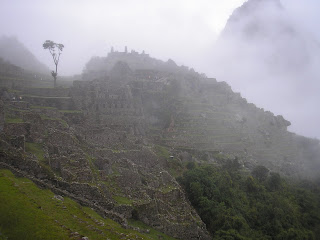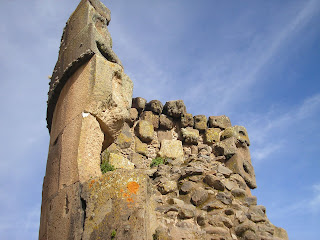How am I supposed to write about the fulfillment of a dream? I have a list of the places in the world I want to see before I die, and Machu Picchu was always my number one. I can now cross that off my list, although after being there once, I would like to go back. Since we arrived in the middle of Peru's rainy season, much of the ruins were shrouded in thick clouds for most of our day. And, of course, it
poured on us, although the most ravaging downpour began at the very end of our tour. At the time, I was devastated that it never cleared up enough that we could see the surrounding mountains in all their majesty, but as the day progressed, I felt that the mysterious veil provided by the clouds was a rather fitting backdrop for the mysteries of the Inca Empire and their most famous city.
Mom and I reached the ruins sometime after 6 a.m., and had some time to wander the grounds before our guided tour at 8 a.m. Theoretically, at this hour of the day, there are less tourists and thus more opportunities to take photos unmolested by large groups of people. We still had to be creative with our camera angles, but I was pretty pleased with the results. And sometimes, you just have to say to hell with it and blast away with the photos in order to capture the scale of the ruins.
Machu Picchu really is everything you expect it to be, which is breath-taking, awe-inspiring, mysterious, beautiful. It is an architectural wonder. It is surrounded by wild mountains and jungle vegetation. The site is richly green. The stones are perfectly formed. Wandering the ruins in (relative) solitude, you can feel the weight of history as you marvel at the Inca's achievements. I wish I were an Inca. The Inca terracing, which we had seen in many other areas, was so beautiful at Machu Picchu, practically clinging to the slope of the mountain. The Incas apparently used the terracing to study the microclimates of each terrace and perfect their crops and farming techniques.
After wandering the site at our leisure, we took a guided tour with a darling and informative guide and were able to learn more about the secrets and marvels of Machu Picchu. I had not known that the site was actually a work in progress when construction was stopped due to the threat of the conquistadores. In places, there are huge piles of boulders that the Inca would shape and use for constructing their buildings. In one area, there was evidence of how the Inca cut the large stones. They would carve niches along natural cracks in the rocks, and then place beams of wood in the niches. Next, they would put water on the wood. As the wood expanded with the moisture, it would split open the rocks. While, standing by the guardhouse overlooking the site, it seemed impossible that a site like Machu Picchu could be built with relative speed, our guide informed us that Incas payed taxes through manual labor, and thus work forces of 20,000 could be mobilized at a time. We stood in the doorway to the site, where the official Inca Trail ended, and learned that the Inca had at one time over 55,000 kilometers of paved trail, stretching from northern Argentina up into Ecuador. We also learned more about their mummies, rituals involving sacrifices to the sun, and the importance of the condor in their worldview. At one place in the site is a ceremonial condor carved out of an existing boulder. Mummified bodies were place on its wings and offerings were made to its carved beak. Other places on the site contained rocks carved and angled to form compasses. We visited the top of a structure that served as an oratorical platform and witnessed the mastery of Inca acoustics, looking down on the field where spectators would stand to listen and where centuries later Che Guevara played a soccer match. Standing among the shadows of the past, Mom and I were mesmerized by the passage of time, the intricacy and achievements of a fallen empire, and our own utter insignificance.
Different views of the living quarters.

 Mom is a conquistadora.
Mom is a conquistadora. 


 Inca walls and a pile of boulders awaiting construction.
Inca walls and a pile of boulders awaiting construction. 
 From the base of the oratorical platform. The Inca terracing is in the distance.
From the base of the oratorical platform. The Inca terracing is in the distance. 
 Mom creeps around Machu Picchu.
Mom creeps around Machu Picchu.

 Machu Picchu seems to cling to the steep slopes of the mountain.
Machu Picchu seems to cling to the steep slopes of the mountain. 

 The phenomenal terracing.
The phenomenal terracing. Machu Picchu as apparition.
Machu Picchu as apparition. 
 The surrounding peaks.
The surrounding peaks.  The site, as seen during a miraculously clear moment.
The site, as seen during a miraculously clear moment.  I never tire of admiring Inca walls.
I never tire of admiring Inca walls. 
After our tour, we ate snacks and waited under a covered area, praying the downpour would stop. No such luck, and I decided to give up and return to Aguas Calientes. I think it was the right decision, since it poured until about 2 p.m., and we had to catch a train back to Cusco at 5. We ate a relaxed dinner and shopped for souvenirs until it was time to board. The train took forever (something like over four hours) and I was anxious to get back to Cusco for our last night because I had a date with a cute boy named Americo! We finally arrived, and Americo took me out dancing at a club where I was literally the only gringa. I was also the tallest person there. This is not an exaggeration; Peruvians are quite short. Due to my gringa-ness and my height, everyone stared at me the entire night, and I was not quite comfortable enough to make a proper show of my dancing abilities. Also, Americo liked to dance to salsa, which I hate, mostly because I can never find the beat and my body does not know how it is supposed to move. However, I was pleased to see the more local scene, since most of our experiences in Cusco were confined to the tourist quarters of the city and thus a little devoid of culture.
So yes, basically, you need to go to Cusco and Machu Picchu. I ended up wishing I hadn't wasted my first three days there being pissy and missing out on all the site-seeing, since Mom and I were unable to do and see it all. Fortunately, it gives me a good reason to go back! I want to try again during the much more popular dry season, which is more crowded but also promises clear skies!
 One of the towers had been struck by lightning, and half of it had come crashing down. It was later discovered that the basalt rock used had metallic properties, which made it vulnerable to lightning strikes.
One of the towers had been struck by lightning, and half of it had come crashing down. It was later discovered that the basalt rock used had metallic properties, which made it vulnerable to lightning strikes.
 A small lake and some farmland, as seen from the top of the hill where many of the funerary towers still stand.
A small lake and some farmland, as seen from the top of the hill where many of the funerary towers still stand.  More remnants.
More remnants. The best part of my day was when Mom asked the guide why the Inca towers were constructed with ridges near the tops. The guide told her the towers were phallic in nature, in keeping with the belief that the next realm of being was feminine and would descend to collect the souls of the dead. After the guide left, I looked at mom and said, "He basically just told you that the Incas wanted to ejaculate their souls into heaven!" We cracked up, because we love penis jokes!
The best part of my day was when Mom asked the guide why the Inca towers were constructed with ridges near the tops. The guide told her the towers were phallic in nature, in keeping with the belief that the next realm of being was feminine and would descend to collect the souls of the dead. After the guide left, I looked at mom and said, "He basically just told you that the Incas wanted to ejaculate their souls into heaven!" We cracked up, because we love penis jokes! 

















































